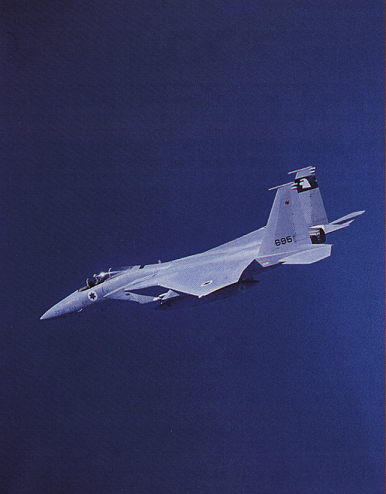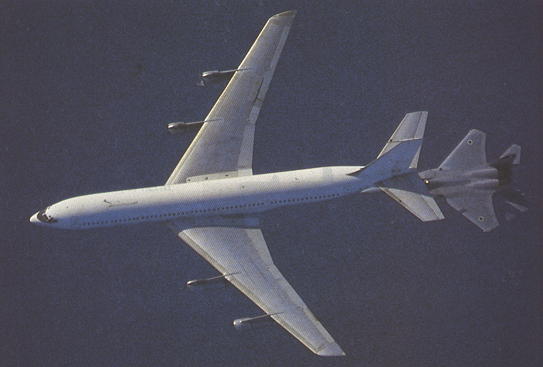October 1st, 1985 - The long reach of the IAF
On September 25th, 1985, three Israelis were murdered aboard their yacht anchored in Larnaca, Cyprus. Responsibility for the murders was taken by the PLO's "Force-17" which had begun its existance as the PLO chairman's personal guard, but which had evolved into actively taking part in anti-Israeli operations. This incident came only three days after PLO terrorists infiltrated Israel's security zone in southern Lebanon and fired rockets on settlements in northern Israel. Within a few hours, the Israeli cabinet had convened and had voted for a retaliatory strike against the PLO. The target chosen - the PLO headquarters on the Tunisian beachfront, where the PLO had taken refuge after its expulsion from Lebanon in 1982. A relatively safe mission, with little chance of detection by hostile countries in North Africa and with no viable threat from the weak Tunisian air force, the biggest threat was the large distance to the target, 1280 miles, flown entirely over water.
 Seeking the most reliable fighter for the mission, the IAF opted for the F-15B Eagle. With its two engines, its midflight refuelling capability, its long range and its load capacity, the F-15 was considered the best aircraft to reach the target and deliver its payload effectively. 10 Eagles were hand picked for the mission, chosen out of the IAF's entire Eagle inventory due to their recorded reliability and small number of faults discovered during their operation. Eight aircraft were to actually take part in the attack, in two waves of four, while the remaining two were backup aircraft. All the aircraft were equipped with precision guided munitions to ensure precise hits on the target, located within a civilian residential area and on the Tunisian beachfront, where vacationers were likely to be found.
Not only were the aircraft hand picked, but so were the pilots, selected from the IAF's best. The mission leader was one of the F-15 squadron commanders.
Seeking the most reliable fighter for the mission, the IAF opted for the F-15B Eagle. With its two engines, its midflight refuelling capability, its long range and its load capacity, the F-15 was considered the best aircraft to reach the target and deliver its payload effectively. 10 Eagles were hand picked for the mission, chosen out of the IAF's entire Eagle inventory due to their recorded reliability and small number of faults discovered during their operation. Eight aircraft were to actually take part in the attack, in two waves of four, while the remaining two were backup aircraft. All the aircraft were equipped with precision guided munitions to ensure precise hits on the target, located within a civilian residential area and on the Tunisian beachfront, where vacationers were likely to be found.
Not only were the aircraft hand picked, but so were the pilots, selected from the IAF's best. The mission leader was one of the F-15 squadron commanders.
On Sunday September 29th, in a briefing with the IDF Chief-of-Staff, the pilots were instructed not to fire their ordnance unless they
were certain of direct hits. The attack had been delayed to Tuesday, October 1st, as the previous two days were holidays in both Israel and Tunisia, thereby ensuring the least chance of detection on the one hand and the least chance of civilian casualties on the other.
At 07:00 on the morning of October 1st, the ten fighters took off and headed westward, on the IAF's longest ranged attack ever.
The aircraft, fully ladden with bombs and AIM-9 Sidewinder air-to-air missiles, were prepared by ground crews unaware of the mission with which the fighters were tasked. The flight took place at medium altitude, far below commercial aviation routes, avoiding a chance encounter with aircraft that might reveal the attackers. The IAF Eagles not only kept away from Egyptian and Lybian radar coverage, sure to alarm their intended target, but also from the U.S. Sixth Fleet patrolling the Mediterranean.

IAF Boeing 707 refuelling F-15 Eagle in mid-flight
At around 10:00, somewhere between Crete and Italy, the F-15 Eagles rendezvoused with an IAF Boeing 707 to refill
their depleted fuel tanks. With the refuelling complete and no faults encountered to this point, the two backup Eagles turned and headed back
to Israel, while the 707 flew on with the fighters. An hour later, after a last and brief refuelling, the Tunisian coastline came in view
and the attack begun.
In two waves, the Eagles descended on the PLO headquarters, releasing their bomb loads. Scoring direct hits, almost the entire PLO complex
was destroyed - including the PLO chairman's bureau and the headquarters of "Force-17", the same organization that had murdered the three
Israelis in Cyprus. Over 60 terrorists were killed, while another 70 injured. The entire length of the attack, the Israeli fighters went
unchallenged, neither by the Tunisian air force, nor by any anti aircraft artillery from the ground.
The attackers had caught their target totally off guard. Having completed their mission, the Eagles could head back home on the three hours'
flight to Israel. Landing at their home base, the Eagle crews were greeted by jubilant crowds - at 13:00, while the aircraft were still
midway to Israel, the BBC had already released news of the successful attack.
back to Operations page
my email : skythe@iname.com
 back to the IDF/AF page
back to the IDF/AF page
 Seeking the most reliable fighter for the mission, the IAF opted for the F-15B Eagle. With its two engines, its midflight refuelling capability, its long range and its load capacity, the F-15 was considered the best aircraft to reach the target and deliver its payload effectively. 10 Eagles were hand picked for the mission, chosen out of the IAF's entire Eagle inventory due to their recorded reliability and small number of faults discovered during their operation. Eight aircraft were to actually take part in the attack, in two waves of four, while the remaining two were backup aircraft. All the aircraft were equipped with precision guided munitions to ensure precise hits on the target, located within a civilian residential area and on the Tunisian beachfront, where vacationers were likely to be found.
Not only were the aircraft hand picked, but so were the pilots, selected from the IAF's best. The mission leader was one of the F-15 squadron commanders.
Seeking the most reliable fighter for the mission, the IAF opted for the F-15B Eagle. With its two engines, its midflight refuelling capability, its long range and its load capacity, the F-15 was considered the best aircraft to reach the target and deliver its payload effectively. 10 Eagles were hand picked for the mission, chosen out of the IAF's entire Eagle inventory due to their recorded reliability and small number of faults discovered during their operation. Eight aircraft were to actually take part in the attack, in two waves of four, while the remaining two were backup aircraft. All the aircraft were equipped with precision guided munitions to ensure precise hits on the target, located within a civilian residential area and on the Tunisian beachfront, where vacationers were likely to be found.
Not only were the aircraft hand picked, but so were the pilots, selected from the IAF's best. The mission leader was one of the F-15 squadron commanders.
 back to the IDF/AF page
back to the IDF/AF page